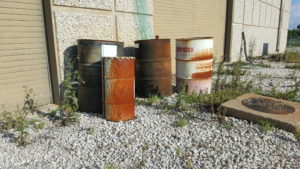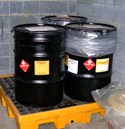In the beginning…there was unregulated disposal of waste generated by commercial and industrial facilities, both public and private. Today there are the hazardous waste regulations written and enforced by the US Environmental Protection Agency and individual states if they have an approved hazardous waste program. So, what was life like for what we now refer to as the “Regulated Community” before there were regulations? Pretty simple for them, but not so good for the environment. Get ready for a history of the Resource Conservation and Recovery Act.
 A common industry practice in those days was to dispose of hazardous waste onsite by burying, burning, or indefinite storage or have it shipped offsite for something similar. In either case records were not required nor kept. Not only did this cause damage to the environment, but the lack of recordkeeping made it impossible for property owners to know what, if any, pollutants were on their property due to past activities.
A common industry practice in those days was to dispose of hazardous waste onsite by burying, burning, or indefinite storage or have it shipped offsite for something similar. In either case records were not required nor kept. Not only did this cause damage to the environment, but the lack of recordkeeping made it impossible for property owners to know what, if any, pollutants were on their property due to past activities.
One cause of this pollution is a flaw in capitalism – a system I love – known as the Tragedy of the Commons. Basically the cost for damage to the environment caused by a polluter were borne by all instead of just the polluter. Thus an incentive for polluters to dispose of waste in the cheapest and the least environmentally-friendly manner possible: open dumping.
Another cause was that the regulation of waste was not thought to be the responsibility of the Federal government and was left to state and local government. This resulted in an inconsistent patchwork of regulations throughout the country. The inter-state transportation of hazardous waste, not to mention the ability of pollutants to cross borders on their own, made effective regulation impossible.
A factor that exacerbated the situation was the increase in the volume and toxicity of waste generated starting in the 1960’s. Note the following statistics from 25 Years of RCRA: Building on our Past to Protect our Future:
- In the decade between 1950 and 1960, the amount of trash individuals created increased 60 percent.
- In 1965, more than four million chemicals were being produced in the U.S. and synthetic chemical manufacturing
was on the rise.
By the 1960’s it was clear that something had to change.
This resulted in the 1965 passage of the Solid Waste Disposal Act (SWDA). The SWDA did not emphasize the regulation of waste throughout its lifecycle, but instead focused on training and research as a means to identify methods to manage waste. It did, however, set minimum standards for local landfills. It had little to no effect on generators of hazardous waste.
The SWDA was amended in 1970 by the Resource Recovery Act (RRA). The RRA emphasized the recovery of energy and materials from solid waste over disposal. Even with this amendment the regulations were still nothing like we know them today. For example: open dumping of waste was not yet banned, companies did not have “Cradle to Grave” responsibility for the hazardous waste they generated, and there was no permit program for hazardous waste generators, transporters, or disposal facilities.
All of that changed in 1976 with the Resource Conservation and Recovery Act (RCRA) which was merely an amendment to the SWDA of 1965, and has been amended itself many times since. However, due to the sweeping nature of the changes it introduced it remains synonymous with the regulation of hazardous waste in the United States. With RCRA, for the first time the generation, transportation, and disposal of hazardous waste came fully under Federal regulations (and state regulations if the state was authorized to manage RCRA) and open dumping of waste was to be banned by 1983.
Like this article? Subscribe to my Monthly Newsletter No marketing emails! |
Read the EPA Press Release – December 13, 1976. Broadly speaking RCRA’s goals were and are:
- To protect human health and the environment from the potential hazards of waste disposal.
- To conserve energy and natural resources.
- To reduce the amount of waste generated.
- To ensure that wastes are managed in an environmentally sound manner.
RCRA is legislation; it is not regulation. It did however authorize the US EPA (created in 1970) to draft the regulations to realize the goals of RCRA. Though not the first regulations to come from RCRA, it is the “Hazardous Waste and Consolidated Permit Regulations,” published in the Federal Register on May 19, 1980 (45 FR 33066; May 19, 1980), which established the basic Cradle to Grave approach to hazardous waste management so familiar to all of us today.
“But wait!” You say, “What were the requirements for a hazardous waste generator from December 13, 1976 – when RCRA was signed into law – to May 19, 1980 when the first hazardous waste regulations were published?” I’m no lawyer, but the best I could determine is that during the period between when RCRA was passed and the regulations were written a generator, TSDF, and/or transporter of hazardous waste need only comply with the regulations in affect at that time: those created by the the Solid Waste Disposal Act of 1965. In other words: “Not much”. Of course, some states and municipalities had out-paced the US EPA and had their own regulations in place well before the RCRA regulations were codified. An example of this is the state of California which passed its Hazardous Waste Control Law in 1972. The HWCL served as a model for RCRA passed four years later and to this day California’s hazardous waste regulations are much more strict and broad than those of the US EPA.
Post-RCRA:
RCRA has been amended many times since its inception, each resulting in a change to the hazardous waste regulations in the CFR. Some amendments were additions, clarifications, and corrections of typographical errors. Others resulted in significant changes to the regulations and affected a large number of the regulated industry. A full description of these amendments will need to wait for a future article. In brief, however, amendments to RCRA are as follows:
Used Oil Recycling Act of 1980 – Intended to encourage the recycling of Used Oil by exempting if from regulation as a hazardous waste if certain requirements are met.
Solid Waste Disposal Act Amendments of 1980 – Intended to provide US EPA with greater enforcement authority over illegal dumping of hazardous waste. It also created a category of large-volume wastes thought to be low-toxicity that were excluded from definition as a hazardous waste and would be categorized as Special Waste.
Hazardous and Solid Waste Amendments of 1984 – These 1984 amendments made the most substantial additions to the program by significantly expanding RCRA’s coverage and requirements for hazardous industrial wastes.
Medical Waste Tracking Act of 1988 – In effect for a limited time (expired in 1991) and for a limited area (4 eastern states and Puerto Rico). The regulation of medical waste is currently the responsibility of the states.
Federal Facility Compliance Act of 1992 – Strengthened enforcement of RCRA at Federal facilities.
Land Disposal Program Flexibility Act of 1996 – provided regulatory flexibility for land disposal of certain wastes.
Contact me with any questions you may have about the generation, identification, management, and disposal of hazardous waste Daniels Training Services, Inc. 815.821.1550 |
Nothing in this article may cause you to substantially change the way you manage hazardous waste. However, knowing the history of the regulations can help to form a broad understanding of where we’ve been and – more importantly – where we’re going as a regulated community. That is why I always include a brief history of US EPA & RCRA in my training. Whether it’s through legislation, interpretation, or enforcement, RCRA is always changing. Make sure your training addresses these changes so you can maintain compliance.

